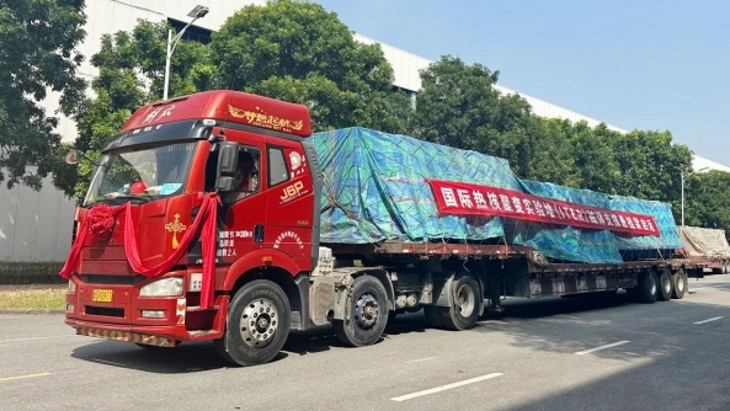China completes ITER magnet support components
A ceremony was held on 3 November to mark the final shipment from China of assemblies for the magnet supporting system of the International Thermonuclear Experimental Reactor (ITER) fusion machine under construction in Cadarache, southern France.

The final consignment of components begins its journey from China for France (Image: CNNC)
The magnet support system - developed and supplied by China National Nuclear Corporation's (CNNC's) Southwestern Institute of Physics - is one of the core structural safety components of the ITER reactor. It includes 18 sets of gravity supports, 72 sets of poloidal field coil supports and 18 sets of correction field coil supports. The total system - weighing more than 1600 tonnes - is responsible for supporting the entire ITER superconducting magnet system and is the load-bearing frame of the ITER device.
"The magnet supporting system is mainly to support the superconducting magnets in the magnetic confinement nuclear fusion, which is also like a backbone of a house," Li Pengyuan, leader of the magnet supporting project, was quoted as saying by CGTN. He noted the system plays a role in bearing the load and counteracting all the electromagnetic forces in order to ensure the safety of the ITER reactor.
The final shipment - which departed from Guangzhou City, Guangdong Province - consisted of 18 sets of poloidal field coils.
CNNC noted, since 2018, the Southwest Institute of Physics has successfully completed the delivery of more than 30 batches of magnet support products.
The company said the timely shipment of the final components "lays the foundation for the major engineering node of the first plasma discharge of the ITER plan, and also lays the foundation for the design and development of China's future fusion reactors".
ITER is a major international project to build a tokamak fusion device in Cadarache, France, designed to prove the feasibility of fusion as a large-scale and carbon-free source of energy. The goal of ITER is to operate at 500 MW (for at least 400 seconds continuously) with 50 MW of plasma heating power input. It appears that an additional 300 MWe of electricity input may be required in operation. No electricity will be generated at ITER.
Thirty-five nations are collaborating to build ITER - the European Union (plus Switzerland) is contributing almost half of the cost of its construction, while the other six members (China, India, Japan, South Korea, Russia and the USA) are contributing equally to the rest. Construction began in 2010.
The timeline for ITER has been for first plasma in 2025 and the start of deuterium-tritium operation in 2035, but that timeline is being revised. In June, the ITER Organisation was expected to reveal the revised timeline for the project but instead put back by a year an announcement on an updated timeline.
Researched and written by World Nuclear News
- China Institute of Atomic Energy
- Nuclear Power Institute of China
- Southwestern Institute of Physics
- China Nuclear Power Operation Technology Corporation, Ltd.
- China Nuclear Power Engineering Co., Ltd.
- China Institute for Radiation Protection
- Beijing Research Institute of Uranium Geology (BRIUG)
- China Institute of Nuclear Industry Strategy (CINIS)
- China Nuclear Mining Science and Technology Corporation


